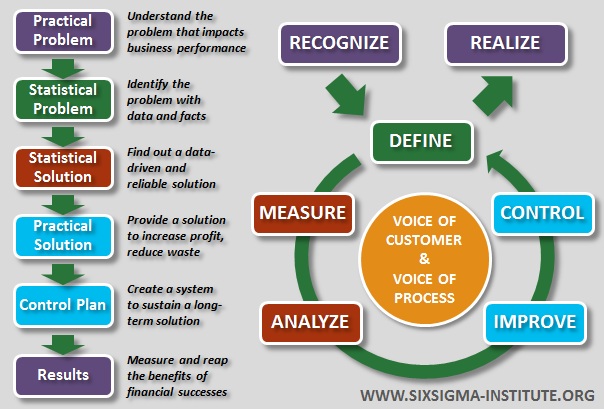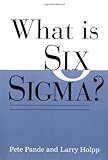What Is Six Sigma?
- ISBN13: 9780071381857
- Condition: New
- Notes: BRAND NEW FROM PUBLISHER! BUY WITH CONFIDENCE, Over one million books sold! 98% Positive feedback. Compare our books, prices and service to the competition. 100% Satisfaction Guaranteed
A brief introduction to Six Sigma for employees Six Sigma is today’s most talked-about system for improving the quality of organizational processes. Written by bestselling author Peter Pande,What Is Six Sigma? is a concise summary of the core themes and processes of Six Sigma. Unlike almost all other books on Six Sigma, it is written for the employees of organizations rolling out Six Sigmanot just managers. This helpful overview describes what Six Sigma is, why companies are implementing it, and how employees can make it a success in their own organizations. Based on the bestselling The Six Sigma Way, this accessable introduction to Six Sigma answers typical employee questions, concerns, and even skepticism about this revolutionary program. Includes: The six themes of Six Sigma A five-step roadmap to Six Sigma implementation The 10 basic tools of Six Sigma, with an entire page devoted to each
List Price: $ 12.00
Price: $ 3.13
Check This:
 The Certified Six Sigma Black Belt Handbook, Second Edition
The Certified Six Sigma Black Belt Handbook, Second EditionThis second edition has been updated and revised to reflect the most recent Six Sigma techniques, and to match the ASQ Certified S…
 Design for Six Sigma for Green Belts and Champions: Applications for Service Operations–Foundations, Tools, DMADV, Cases, and Certification
Design for Six Sigma for Green Belts and Champions: Applications for Service Operations–Foundations, Tools, DMADV, Cases, and CertificationThis is the eBook version of the printed book.Most Six Sigma books are targeted at manufacturers, and don’t reflect the unique imp…
 Certified Six Sigma Green Belt Exam Secrets Study Guide: CSSGB Test Review for the Six Sigma Green Belt Certification Exam
Certified Six Sigma Green Belt Exam Secrets Study Guide: CSSGB Test Review for the Six Sigma Green Belt Certification ExamCertified Six Sigma Green Belt Exam Secrets helps you ace the Six Sigma Green Belt Certification Exam, without weeks and months of…
 The Lean Six Sigma Pocket Toolbook: A Quick Reference Guide to 100 Tools for Improving Quality and Speed
The Lean Six Sigma Pocket Toolbook: A Quick Reference Guide to 100 Tools for Improving Quality and SpeedBestselling Lean Six Sigma author Michael George provides the first pocket guide for deployers of Lean Six Sigma The Lean Six S…



Good introduction if you know nothing about Six Sigma,
I had heard often of Six Sigma, but knew next to nothing about it (and suspected an overdose of trendy nonsense because of the silly sounding terms borrowed from karate). This slim volume seemed the right starting place, since I did not wish to invest in a tome of material if Six Sigma turned out to uninteresting for my company.
This is, indeed, an excellent overview. It tells in global terms what to expect. The statistical methods are described in non-mathematicians’ intuitive terms (a pity, I would have liked a little more detail) but for my needs it served it purpose admirably.
As a result of reading this book I am moving on to a more technical account of Six Sigma. I need to know what the operational definitions are and how the statistics are used. I am not yet certain if Six Sigma is suitable – in software development we have established methods for tracking bugs and improving interface usability. Nevertheless, my interest has been whetted.
Was this review helpful to you?

|All The 6 Sigma Basics and Just the Basics,
Of the Six Sigma books I’ve read, this is the one I’d recommend most highly. It will give you the basic “tools” of Six Sigma in a compact, useable form. I feel that this would be an excellent text for corporate training on Six Sigma, certainly for an introductory course.
A quick read of the reviews on Amazon will give you a feel for why people are skeptical of 6 Sigma: the feel-good tone of most writing on 6 Sigma and the insistence that it “is not a flavor-of-the-month management trend” make many of us suspect that 6 Sigma is not much more than hollow jargon and acronyms.
Lets accept that these criticisms are valid and further that many “practitioners” are just self-aggrandizing or worse. But that still leaves us with the essential difficulties of positive change in any organization: you need to overcome assumptions that your organization’s subculture may not even realize it has. What a corporation does by accepting Six Sigma is that it empowers people to gather data to challenge what “everybody knows”. Most importantly, it sets a very high quality standard, which reinforces the sanctioning of data-driven change.
The authors of “What is Six Sigma” put it very well early on: “proactive management means making habits out of what are, too often, neglected business practices: defining ambitious goals and reviewing them frequently, setting clear priorities, focusing on problem prevention rather than firefighting, and questioning why we do things instead of blindly defending them.”
I feel that the greatest flaw in Six Sigma is that many practitioners and even the books permit the basics to be lost in the shuffle. If one listens to people talk about Six Sigma, its easy to forget that a critical part of Six Sigma is that the data comes first, not the solution. I often hear co-workers say “we need to finish this project to improve our six sigmas” or “if we could get rid of this server we’ll all get our green belts”.
The term Six Sigma is derived from statistics and many books gloss over the statistics and move right on to basic project management techniques or how to overcome objections to Six Sigma. This book gives a clear and brief explanation of how to calculate standard deviations and includes a handy table to help with determine “sigma levels”. Every Six Sigma book should respond to the challenge raised by this book and also include this information in the first 10 pages.
Finally, I recommend this book because it is concise and to-the-point. I feel that the fluff and/or Machiavellian advice in many of the other books just feed into people’s healthy skepticism and distract people from the beauty of Six Sigma: the challenge to strive for near-perfect quality and the sanction to use statistics to cut through the inertia in our work lives.
I would also recommend Michael Lewis’ “Moneyball” (ISBN 0393057658) as a companion book. Lewis (author of “Liar’s Poker”) uses Wall Street trading as an analogy to explain why the Oakland As baseball team is one of the successful teams with much less money than most. But I also see an analogy relevant to the topic of Six Sigma. “Moneyball” shows how one can achieve superior results by testing what everyone thinks they know with fact gathering and rigorous analyses. Moneyball and “What is Six Sigma” may prove to be an inspiring combination.
Was this review helpful to you?

|